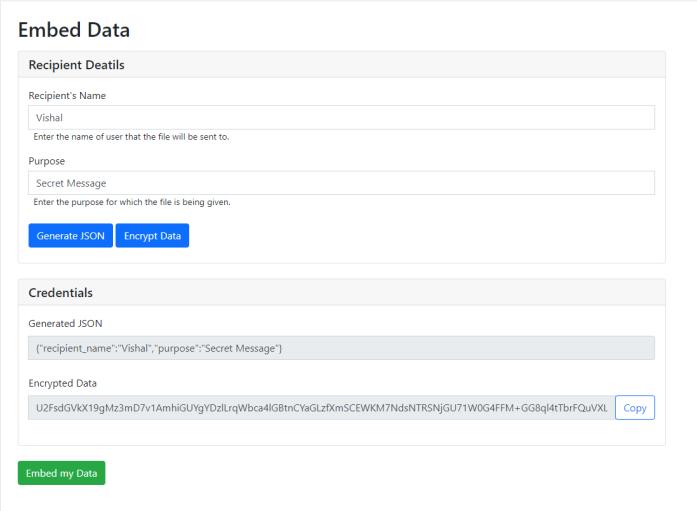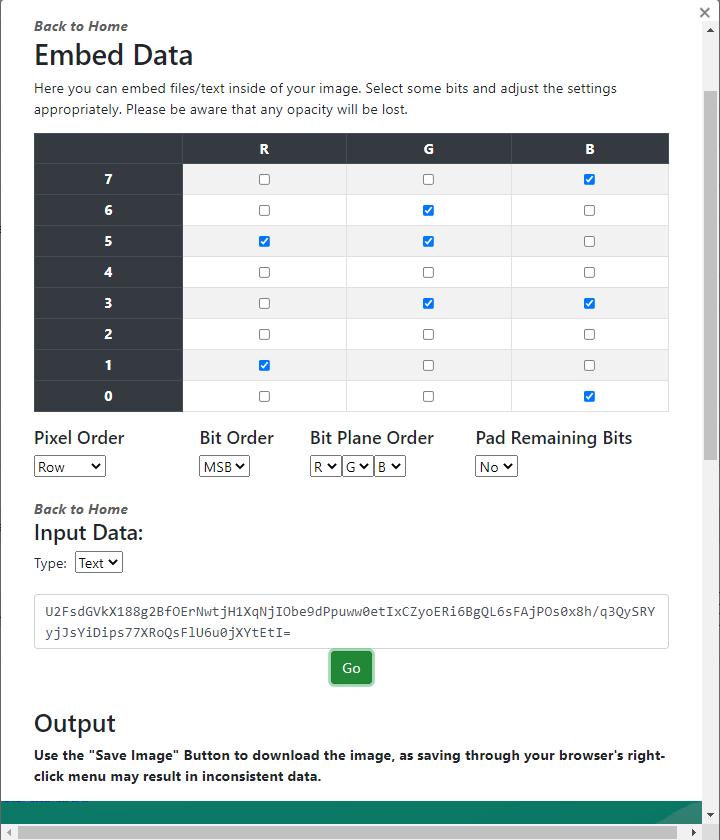International Research Journal of Engineering and Technology (IRJET) e-ISSN:2395-0056

Volume: 09 Issue: 12 | Dec 2022 www.irjet.net p-ISSN:2395-0072
Implementation of Steganographic Techniques and its Detection.
Abstract - There is a huge development in Computer technology in the past few decades and the question of information security rises. To solve this problem different methods have been used to cover the secret message with common media. Solutions such as Steganography and Cryptography are used to tackle this problem. The method of steganography is among the methods that have received attention in recent years. We have come up with a system for applying steganographic techniques to conceal (hide) and retrieve the provided information inside of digital files (primarily images and text files) and to create a classifier to detect if some information is hidden in digital images. Unlike cryptography, which works to obscure content so it can't be understood, steganography's goal is to hide the fact that content exists at all by embedding it in something else. The proposed system will include an interface to hide and retrieve messages in images and videos and documents. This way a steganographic image can be created and transported and then the secret information can be retrieved. The proposed system will also include a classifier trained to detect common techniques of steganography and hence can be used to detect if an image contains hidden information or not.
Key Words: Hide,Steganography,image,text
1. INTRODUCTION
Inthecurrentworld,thereisahighneedofaprivatepeer to peer communication system. Here is where a place for Steganography comes into picture. A tool through which one can communicate by hiding a privatesecret message is a necessity in this monitored world. The method of steganographyisareallypopularmethodifconcealing,
The main goal of steganography is to hide secret information in the other common forms of media so that anyone who does not know about this secret message cannot understand it or notice it. This is a major distinction between this method and the other methods like cryptography. In Cryptography, the user will notice the information by seeing the encrypted information but theywillnotbeabletodecodetheinformation.Meanwhile in steganography, the existence of the information in the mediaisnotnoticedbytheuser.
The use case for such a system is primarily in digital watermarking for copyright and licencing protection by identifying the digital asset by its watermark and also to detect tampering. It could also be used for digital fingerprinting of media, so that its source can be tracked or verified, for example to find the culprit of film (movie) piracy, sensitive documents being leaked,etc. Other usage include covert (secret) communication, that is, it can be used to transport sensitive data from point A to point B suchthatthetransferofthedataisunknowntoevadeany potentialeavesdropper.Itcanalsobeusedincombination with cryptography, for more protection. Other potential usageincludesstoringofsecretinformationataplace.
1.1 OBJECTIVES
The objective of this project is to implement a system to apply steganographic techniques to an image / or other file types so as to hide information in them. This would achievethefollowingdesiredresults
1. Information would be concealed in the image unknowntothirdparties.
2. The image can then be transferred to the desired recipient without anyone knowing about the secret communicationtakingplace
3. The recipient can then extract the secret informationfromthereceivedimage.
2. LITERATURE SURVEY
Information concealing is the most important method of steganography. In computing general technique is to concealasecretmessageineverynthbitofeveryplaceof a digital message. After the introduction of the Internet and all the different digital file formats that it has decreased in importance. Steganography is mainly implemented in Text, Images, Video or Audio forms of media. Below is a Diagram showing various methods of Steganography,
International Research Journal of Engineering and Technology (IRJET)

e-ISSN:2395-0056
Volume: 09 Issue: 12 | Dec 2022 www.irjet.net p-ISSN:2395-0072
3. EXISTING SYSTEM ARCHITECTURE
Themaingoalofthismethodistohideinformationonthe outputimage. Thismethod canbeused tosendthe image as a normal conversation or for announcing a secret message ina publicplace.Usinga suitableSteganography algorithm the secret information is hidden within the normaldatabeforesending.
Fig
-1:MethodsofSteganography
Belowisthesummaryofvariousresearchpapers:
Digital Steganography and watermarking for digital images: a review of current research directions. (Oleg Evsutin,AnnaMelmanAndRomanMeshcheryakov.)Issue5,September,2020.
This system shows various methods used in hiding and digital watermarking. It provides basic information about this field and the main applications. It focuses on contemporary works illustrating current research directions in the field of information embedding in digital images.
An Effective and Secure Digital Image Steganography scheme using two Random function and Chaotic Map. (MohanandNajmAbdulwahed) Issue-15,January2020
The proposed system suggests a secure image steganographic system which is a key adaptive LSB system,whichdependsonfourstagesfortheprovisionof better data-hiding algorithms in cover images by the volume, image quality, and security. In this paper a new adaptive of least significant bit substitution technique, mergingtworandomfunctions,andchaotictechnique.
Digital Steganography for preventing Cybercrime using Artificial Intelligence Technology. (Dr. R. Varalakshmi)Issue-8,February2020.
It is observed that the proposed algorithm shows improvementthantheexistingalgorithm.Thecoverimage (RGB) using an embedding algorithm using Karhunen Loeve Transform for communication with the secret message taken as input. It converts an encoded image which hides the secret. This encoded image is decoded using a decoding algorithm (DES) to revert the original secretmessage.
Fig -2:ImplementationofSteganographicEncryption


Encrypt Data
The current system allows the user to select a cover image,andembedasecretmessageinsidethecoverimage
This operation uses the LSB Algorithm and embeds the binary data into different pixel value data of the cover image.
This uses an Encryption key and has a temp file which storesthedata ifthepixel bitvalueandthedata bitvalue are same or different. Thus a steganographic image is created.
Extract Data
The current system allows the user to upload the Steganographic image and Decrypt the data out of the imageusingLSBandthetempvalues.
Disadvantages
One of the defects of the current system is that the user cannot choose which bit planes to embed the data in, there’snocontrolinthehandsoftheuser.
One more extra security protocol is to encrypt the data before embeddingitwitha privatekey sothat even if the Steganography is detected and the data is extracted
International Research Journal of Engineering and Technology (IRJET) e-ISSN:2395-0056

Volume: 09 Issue: 12 | Dec 2022 www.irjet.net p-ISSN:2395-0072
there’llbeanextralayerofsecurityandtheuserwon’tbe abletoextracttheinformation.
4. PROPOSED SYSTEM ARCHITECTURE
In our system we have fixed the two disadvantages mentionedaboveintheexistingarchitecture.
Oursystemprovides:
1. Encryption ofdata beforeEmbeddingdata toadd anextralayerofsecurityfortheuserbeforeLSB.

2. Giving the user choice to select the bit planes he wishes to embed the data in. The user can lower the distortion in image by embedding data into the lower bit planes.
3. An activity column to fetch all of the recent Steganographicoperationsbytheuser.
4. ASteganographyDetectiontool.
User Profile: Login/ Register
The Secure Login system logs the user into his profile which has the data of all of his Steganographic operation activities.
Eachprofileisassignedauniqueprivatekeywhichisused to encrypt and decrypt the data and can only be accessed bytheuser.
New Users can create new profiles to access these features.
Embed Data
Fig -5:Dashboard
In embed data the sender can upload a file to generate a steganographicimagewithconcealeddata.Decideddatais encrypted using AES 256 first, creating encrypted data which is then concealed into a file decided by the use of LSB algorithm and unique pattern of bit plane decided by user.
Fig -4:Login/Registersystem.


Dashboard
The Dashboard shows the basic operations of the Stegno tool Portal in an organized manner, It also shows the recentsteganographic embeddingactivities ofthecurrent userloggedin.

Fig -6:CreatingEncryptedsecretmessage
Here, the user can perform various operations with the imageselected.
Someoftheoperationsare:
FullRed/Green/Blueimage
InvertedImage
Embed/ExtractData EmbedB&Wimage
Showstrings,RGBAvalues
International Research Journal of Engineering and Technology (IRJET) e-ISSN:2395-0056

Volume: 09 Issue: 12 | Dec 2022 www.irjet.net p-ISSN:2395-0072
Fig -7:AvailableImageOptions.



Fig -8:FullRedOption.
Here, the usercanselect whichbit planes the data should be embedded in the image and paste the encrypted AES text in the data section and complete the embedding operation.
Fig -9:Embeddingdataintoselectedbitplanes.
Extract Data
Here steganographic image with concealed data is extracted by firstly retrieving concealed encrypted data fromstreganaphicimage.Thenretrievedencrypteddatais decryptedusingaprivatekey.
The user has to select the same bit planes he used for embeddingthedata.
Fig -10:SelectingthebitplanestoExtractdata

International Research Journal of Engineering and Technology (IRJET)

e-ISSN:2395-0056
Volume: 09 Issue: 12 | Dec 2022 www.irjet.net p-ISSN:2395-0072
The results are shown. The user now copies the ASCII valueanddecrypttheAESEncryption,
About
Intheabouttab,thecruxoftheprojectisexplained.
Fig -14:Abouttab
Fig
-11
:ResultsofDataExtraction
OncetheuserenterstheASCIIvalueanddecryptshegets in return the original JSON value of the secret message. TheseoperationsarestoredintheActivitytab.
5. Algorithm
Step 1) User creates an account using the registration system.
Step 2) Userloginswithcredentialsusermade.
Step 3) Fromdashboarduserselectsifhewantstoembed datainfileorextractdatafromencryptedfile.
Step 4)To embed data in the data embed tab, the user generatesajsonusingtherecipient'snameandpurpose.

Step 5) Userselectstheencryptfeature.

Step 6) User uploads image to conceal data into image usinguniquebitplane.
Fig -12:Embeddingdataintoselectedbitplanes.
Activity
In the activity tab history of user activity is logged, it tracks the data sent thus it can be used to check if a file that belonged to the is tampered with. It's also used in detecting to which user the file belongs using respective hash.Allthedataisstoredinadatabase.
Step 7) The user embeds the data and downloads the Steganographicimage.
Step 8) To decrypt the image, the user enters encrypted dataintheextracttab,afterenteringdatalength.


Step 9) Userselectsdecryptdatabutton.
Step 10) Finish.
6. TECHNIQUE USED
LSB Algorithm
The LSB algorithm replaces the last bit which is the least significant bit of each pixel with the secret message’s one databit.
Fig -13:Activitytab
The Least Significant bit (LSB) has the lowest impact on imagecolororqualitywhenitischanged.E.g.Ifthepixelis black and it’s value is 1 and it is changed from 1 to 0, the
International Research Journal of Engineering and Technology (IRJET) e-ISSN:2395-0056

Volume: 09 Issue: 12 | Dec 2022 www.irjet.net p-ISSN:2395-0072
pixel coloronlychangesfromBlack toalighterversionof black.Thechangeinbytesis<0.000002%.
Working
EverypixelhasaRGBvaluerangingfrom0to255.
In LSB, if the user wants to insert a secret text message into an image, The secret message is first converted into Binary.
E.g. Secret message is “Steg” is converted to ‘01010011 011101000110010101100111’.
Thisbinaryvalueofthesecretmessageisthen embedded intotheimagedatausingLSBtechnique.
The Algorithm first takes the image data and converts it intopixelvalue.
TheAlgorithmthenreplacestheleastsignificantbitofthe 8-bitimageRGBpixelwiththefirstbitbinaryvalueofthe secretmessage.
Thiscontinuestillallofthebitsaresuccessfullyembedded intothepixelvalue.
This is how Encryption of secret message into the cover imageworksandaSteganographicimageisproduced.
For the Decryption part, this algorithm reverses the processanddecodesthesecretmessage.
This system will be primarily used in digital watermarking for copyright and licencing protection by identifying the digital asset by its watermark and also to detecttampering.
Other usage include covert (secret) communication, that is, it can be used to transport sensitive data from point A topointBsuchthatthetransferofthedataisunknownto evade any potential eavesdropper. It can also be used in combinationwithcryptography,formoreprotection.
8. ACKNOWLEDGEMENT
We would like to extend our deepest gratitude to our Project guide Prof. Amol Kharat for his exemplary guidance, monitoring and constant encouragement throughout this project which helped us improve our work.
WewouldalsoliketoextendourgratitudetoourHeadof Information Technology Department Dr. Satishkumar Varma forprovidinguswithanopportunityandplatform tocarryoutthisproject.
We are also extremely grateful to our Principal Dr. Sandeep Joshi who provided us with this golden opportunityaswellasallthefacilitiesneededtocarryout thisprojectsuccessfully.
9. REFERENCES
[1]N.F.JohnsonandS.Jajodia,"Exploringsteganography: Seeing the unseen," in Computer, vol.31, no. 2, pp. 26-34, Feb. 2018, doi: 10.1109/MC.1998.4655281. https://ieeexplore.ieee.org/abstract/document/4655281
[2]Morkel,Tayana,JanHPEloff,andMartinS.Olivier."An overview of image steganography." ISSA. Vol. 1. No. 2. 2019.http://www.academia.edu/download/54323461/E N_-_Image_Steganography_Overview.pdf
Fig -3:LSBAlgorithmDataencrypting.
The current existing system uses the Embedding and ExtractingdatabasedontheaboveLSBalgorithm.

7. CONCLUSIONS
The Project will demonstrate the application of steganographic techniques in real world scenarios. The systemwillprovidetheuserswithaneasytouseinterface forhidingandretrievingsecretinformationinanimage.It will be helpful in providing a secure communication mediumandalsothefollowingapplications.
[3] N. Provos and P. Honeyman, "Hide and seek: an introduction to steganography," in IEEE Security & Privacy, vol. 1, no. 3, pp. 32-44, May-June 2020, doi: 10.1109/MSECP.2003.1203220. https://ieeexplore.ieee.org/abstract/document/1203220
[4]Channalli,Shashikala,andAjayJadhav."Steganography an art of hiding data." arXiv preprint arXiv:0912.2319 (2016).https://arxiv.org/pdf/0912.2319
[5] Evsutin et al 2017 J. Phys.: Conf. Ser. 803 012038 https://iopscience.iop.org/article/10.1088/17426596/803/1/012038/pdf
